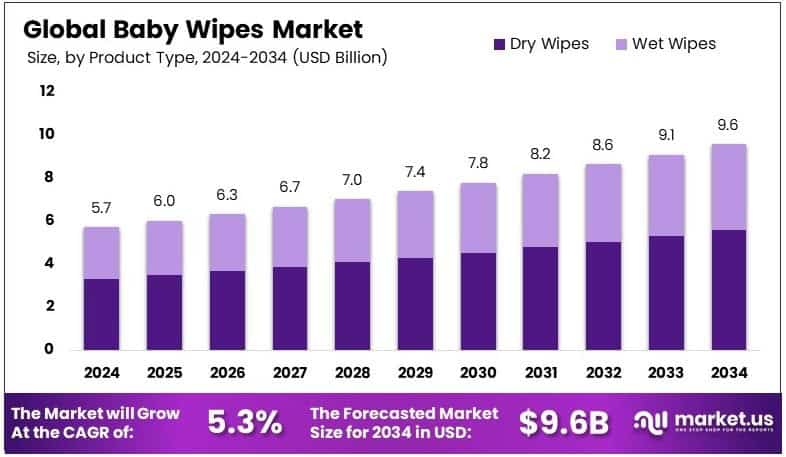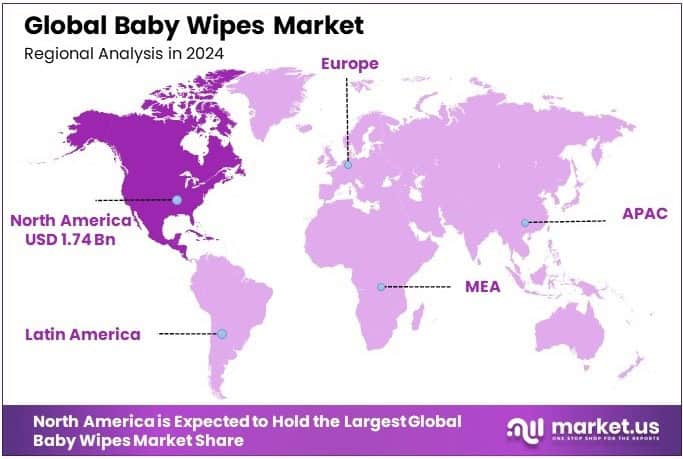Table of Contents
Introduction
New York, NY – March 28, 2025 – The Global Baby Wipes Market is projected to reach approximately USD 9.6 billion by 2034, rising from an estimated USD 5.7 billion in 2024. This growth is anticipated to occur at a compound annual growth rate (CAGR) of 5.3% during the forecast period from 2025 to 2034.
Baby wipes are moistened towelettes specially formulated for cleaning the sensitive skin of infants, primarily used during diaper changes to maintain hygiene and reduce the risk of skin irritation or rashes. These products are typically infused with gentle cleansing agents, moisturizing ingredients such as aloe vera or vitamin E, and are often dermatologically tested to ensure they are safe for daily use. The baby wipes market refers to the global industry involved in the production, distribution, and sale of these wipes, which are available in a range of variants including scented, unscented, biodegradable, and antibacterial options.
The market is characterized by high demand from households, hospitals, and childcare centers, driven by growing awareness of infant hygiene and the increasing emphasis on convenience in parenting routines. Urbanization, rising disposable incomes, and dual-income households have significantly influenced consumer behavior, resulting in a higher preference for time-saving baby care products. Furthermore, the expanding penetration of organized retail and e-commerce platforms has enhanced product accessibility, thereby accelerating market expansion.
Key growth factors include the rising birth rate in developing countries, ongoing product innovations focusing on skin safety and sustainability, and growing parental concern for safe and effective infant care solutions. In addition, increasing consumer interest in organic and biodegradable baby wipes presents a substantial opportunity for manufacturers to invest in eco-friendly formulations and packaging. As regulatory focus intensifies around the safety and environmental impact of baby care products, companies adopting sustainable practices and transparent labeling are likely to gain a competitive edge and align with evolving consumer preferences.

Key Takeaways
- The Baby Wipes Market was valued at USD 5.7 billion in 2024 and is projected to reach USD 9.6 billion by 2034, expanding at a Compound Annual Growth Rate (CAGR) of 5.3%.
- In 2024, Dry Wipes dominated the market, accounting for a substantial 58.2% share.
- Cotton emerged as the leading material type in 2024, driven by consumer preference for natural, soft, and highly absorbent materials.
- Supermarkets and Hypermarkets led the distribution channel segment in 2024, holding a 30.1% market share.
- North America was the leading regional market in 2024, contributing 30.5% of the global revenue, equating to USD 1.74 billion.
Request immediate access to a complimentary sample copy of this detailed industry report at https://market.us/report/baby-wipes-market/request-sample/
Report Scope
| Report Features | Description |
|---|---|
| Market Value (2024) | USD 5.7 Billion |
| Forecast Revenue (2034) | USD 9.6 Billlion |
| CAGR (2025-2034) | 5.3% |
| Segments Covered | By Product Type (Wet Wipes, Dry Wipes), By Material (Cotton, Non-Woven, Polyester, Others), By Distribution Channel (Online Retail, Supermarkets or Hypermarkets, Specialty Stores, Pharmacies, Others) |
| Competitive Landscape | Procter & Gamble Co., Kimberly-Clark Corp., Johnson & Johnson, Unilever Plc., The Honest Company, Hengan International Group, Pigeon Corporation, Sebamed, Mother Sparsh Baby Care Private Limited, Me N Moms Pvt. Ltd., Himalaya Global Holdings Ltd., Dabur India Limited, Smart Care |
Emerging Trends
- Eco-Friendly and Biodegradable Products: There is a growing demand for baby wipes made from biodegradable materials, reflecting increased environmental consciousness among consumers.
- Hypoallergenic and Sensitive Skin Formulations: Manufacturers are developing wipes with gentle, hypoallergenic ingredients to cater to infants with sensitive skin, reducing the risk of irritation and allergies.
- Innovative Packaging Solutions: Companies are introducing user-friendly packaging, such as resealable pouches and single-dispense designs, enhancing convenience and maintaining product moisture.
- Infusion of Natural Ingredients: The incorporation of natural extracts like aloe vera and chamomile in baby wipes is on the rise, offering additional skin-soothing benefits.
- Technological Advancements in Manufacturing: Enhanced manufacturing techniques are being adopted to produce ultra-soft, durable, and highly absorbent wipes, improving overall product quality.
Top Use Cases
- Diaper Changes: Baby wipes are predominantly used during diaper changes to cleanse the diaper area, ensuring hygiene and preventing diaper rash.
- Hand and Face Cleaning: Parents utilize wipes to clean infants’ hands and faces, especially after meals or outdoor activities, providing a quick and convenient cleaning solution.
- On-the-Go Hygiene: The portability of baby wipes makes them ideal for maintaining infant hygiene during travel or outings where traditional washing facilities are unavailable.
- Toy and Surface Cleaning: Baby wipes are employed to clean toys, high chairs, and other surfaces that infants frequently contact, reducing exposure to germs.
- Personal Use by Adults: Beyond infant care, baby wipes are increasingly used by adults for personal hygiene purposes due to their gentle and moisturizing properties.
Major Challenges
- Environmental Concerns: The disposal of non-biodegradable wipes contributes to environmental pollution and landfill waste, prompting calls for more sustainable alternatives.
- Skin Irritation Issues: Some wipes contain chemicals and fragrances that may cause skin irritation or allergic reactions in infants, leading to consumer apprehension.
- Regulatory Compliance: Manufacturers must navigate stringent regulations and safety standards to ensure product safety and efficacy, which can be resource-intensive.
- Intense Market Competition: The presence of numerous brands offering similar products results in price wars and challenges in differentiating products in a saturated market.
- Supply Chain Disruptions: Fluctuations in the availability and cost of raw materials can impact production schedules and profitability for manufacturers.
Top Opportunities
- Expansion in Emerging Markets: Rising birth rates and increasing disposable incomes in developing regions present significant opportunities for market growth.
- Development of Organic Products: Creating organic and chemical-free wipes caters to health-conscious parents seeking safer alternatives for their infants.
- E-Commerce Growth: The surge in online shopping allows companies to reach a broader customer base and offer subscription models for regular delivery of baby wipes.
- Customization and Personalization: Offering wipes tailored to specific skin types or infused with preferred natural ingredients can attract niche segments of consumers.
- Collaborations and Partnerships: Partnering with healthcare providers or parenting organizations can enhance brand credibility and expand market reach through trusted recommendations.
Key Player Analysis
In 2024, the global baby wipes market was characterized by the strategic initiatives of key players aiming to meet evolving consumer preferences. Procter & Gamble Co. maintained its market leadership through the Pampers brand, emphasizing product innovation and extensive distribution networks. Kimberly-Clark Corporation continued to strengthen its position with the Huggies brand, focusing on product quality and expanding its global reach.
Johnson & Johnson leveraged its longstanding reputation to offer gentle and safe baby wipes, catering to health-conscious parents. Unilever Plc. diversified its portfolio by incorporating baby wipes into its extensive range of personal care products, capitalizing on its global presence. The Honest Company differentiated itself by promoting eco-friendly and hypoallergenic wipes, appealing to environmentally conscious consumers. Hengan International Group and Pigeon Corporation expanded their influence in the Asia-Pacific region by addressing local consumer needs. Sebamed focused on dermatologically tested wipes suitable for sensitive skin.
Indian companies such as Mother Sparsh Baby Care Private Limited, Me N Moms Pvt. Ltd., Himalaya Global Holdings Ltd., and Dabur India Limited capitalized on the growing demand for natural and herbal products in domestic and international markets. Smart Care emphasized affordability and accessibility, targeting price-sensitive segments. Collectively, these companies contributed to a dynamic and competitive market landscape, driving innovation and catering to diverse consumer preferences.
Top Companies in the Market
- Procter & Gamble Co.
- Kimberly-Clark Corp.
- Johnson & Johnson
- Unilever Plc.
- The Honest Company
- Hengan International Group
- Pigeon Corporation
- Sebamed
- Mother Sparsh Baby Care Private Limited
- Me N Moms Pvt. Ltd.
- Himalaya Global Holdings Ltd.
- Dabur India Limited
- Smart Care
Gain complete access to in-depth market insights by securing your full report today at https://market.us/purchase-report/?report_id=137135
Regional Analysis
North America has emerged as the leading regional market in the global baby wipes industry, commanding the largest market share of 30.5% in 2024, with an estimated market valuation of approximately USD 1.74 billion. This regional dominance is primarily attributed to the heightened consumer awareness regarding infant hygiene, high disposable income, and the widespread availability of premium baby care products.
The market has also been supported by an increase in birth rates in certain U.S. states, coupled with a surge in demand for chemical-free and hypoallergenic wipes, particularly among millennial and Gen Z parents who prioritize natural and sustainable products for their infants.
The region benefits from a well-established retail infrastructure, including hypermarkets, supermarkets, and e-commerce platforms, which facilitate the widespread distribution and easy accessibility of baby wipes. Moreover, the presence of major industry players such as Procter & Gamble, Johnson & Johnson, and Kimberly-Clark in the United States has significantly bolstered product innovation and marketing outreach, further strengthening market penetration.
Additionally, the growing trend of convenient and travel-friendly baby hygiene products has spurred demand for portable baby wipes across the U.S. and Canada. With ongoing investments in organic and biodegradable product development, North America is expected to maintain its leading position in the global baby wipes market over the forecast period.

Recent Developments
- In 2024, DOMS Industries Limited expanded its business portfolio by acquiring a 51.77% equity stake in Uniclan Healthcare for ₹54.88 crore. With this move, Uniclan Healthcare has now become a subsidiary of DOMS. The decision supports DOMS’ strategic goal to enter the baby hygiene market. The acquisition is expected to help DOMS strengthen its presence in the personal care sector while broadening its product offerings and market reach.
- In 2023, Ginni Filaments Ltd introduced a new standard in baby wipes with the launch of ultra-pure wipes made of 99.9% water. Designed especially for sensitive infant skin, these wipes use minimal ingredients to ensure maximum safety and comfort. The product is developed with a focus on purity and softness, positioning it as one of the gentlest solutions in the Indian baby care market.
- In 2023, Sophie la Girafe Babycare entered the baby wipes segment with the launch of 99% water-based wipes. These wipes are crafted with only seven natural, skin-friendly ingredients, offering a gentle and effective cleansing solution. The brand’s approach reflects a commitment to clean, bio-sourced skincare for newborns and infants, focusing on safety and simplicity.
Conclusion
The baby wipes market is expected to grow steadily, supported by rising awareness of infant hygiene, increasing demand for convenient baby care products, and a shift toward eco-friendly and skin-safe formulations. While environmental concerns and market competition present challenges, opportunities in emerging markets and innovations in organic and biodegradable products are expected to drive future expansion. Companies focusing on sustainability, quality, and accessible distribution are likely to maintain a competitive advantage in the evolving market landscape.
Discuss Your Needs With Our Analyst
Please share your requirements with more details so our analyst can check if they can solve your problem(s)





